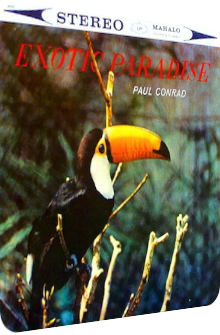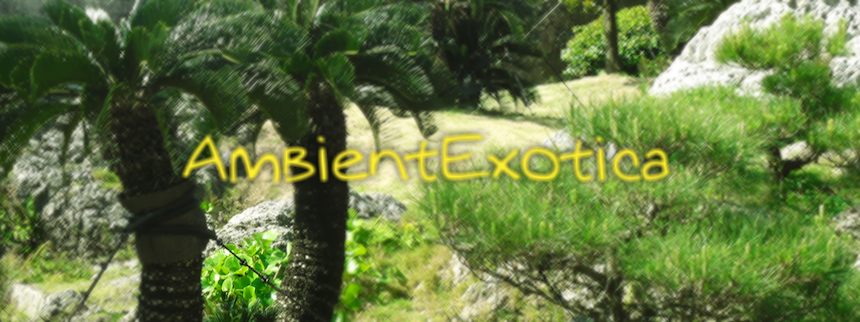
Paul Conrad
Exotic Paradise
1963
Paul Conrad was a pianist for Gene Rains but left the quartet in 1960 after their debut LP Lotus Land and was able to come up with his own Exotica album called Exotic Paradise in 1963 which remains the only record by Paul Conrad – and as usual one has to ask why this is the case, for Conrad has an ear for catchy, care-free and glistening Exotica tunes … with darker substructures! It paid for Conrad to be a pianist in Rains‘ band, for he decided to focus on the presentation of a different variety of tracks that were seldomly played. The iconic toucan and the blurry papier-mâché background are the first visible hints of the overarching theme, namely coming up with Exotica and Jazz classics from all over the world that are spiced with a subtropical flavor and Eastern tidbits.
Among the jewels on this LP are a rendition of the 55 Days At Peking theme, a film with Charlton Heston in the main role which was released in the same year, and the real Japanese classic Gomen Na Sai (meaning Sorry) as well as the Philippine folk song Sa Libis Ng Nayon. The existence of these two songs on Conrad‘s album can be considered as a farsighted addition to the commonplace 12-song playlist, for the pianist takes the opportunity to present these imported songs to an audience that doesn‘t know them yet. Due to their relative obscurity, these two songs alone make Exotic Paradise an interesting album beyond the standard repertory of Exotica artists – even though versions of Shangri-La and Deep Night are on there as well. Conrad uses the piano and xylophone as his main instruments and occasionally adds a guitar. The percussive main ingredient consists of bongos. Although there isn‘t an overwhelming pool of instruments used on the album, the reduced approach perfectly carves out the melodies and the coherent presentation which, surprisingly, is traversed by occasional frissons of cheekiness.
Paradise starts with beautifully cascading piano and xylophone notes and additional guitar pluckings which bring a glimpse of surf rock to the song. If you listen carefully, you will detect a sound that resembles gurgling water or pearl necklaces that are rubbed together. This percussive particularity makes this a special song and starts the album in a great way. Shangri-La is a blast and begins with the well-known, mesmerizing piano hooks that are accompanied by a xylophone and surprisingly loud wind chimes that are soothing and add a certain plasticity to the classic. The bongo groove in Conrad‘s version of Deep Night is worth mentioning, for this ingredient enhances the Exotica flavor of the song in the first half that is dreamy and pleasant as usual – it‘s the second half that turns things up a notch: staccato drums and punchy piano notes refer to the other meaning of a deep night loaded with dance sessions and conviviality, before the track morphs back into the glinting xylophone-laden mystique.
Gomen Na Sai is a sneaky Japanese rock song with a condescending piano and an in-your-face-attitude that is seldomly heard on Exotica albums. Naturally, Conrad cannot force himself to succumb to this kind of nastyness, and that‘s why harmonious and fleet-footed counterparts are woven in, consisting of euphonious piano chords. Definitely one of the most distinct songs on any Exotica album; I like it quite a bit! 55 Days At Peking introduces military marches to the album‘s variety of styles. Unfortunately, the song is too far off from exotic climes. The mood is almost spectral and too mercurial, but one thing makes me laugh: the counterintuitive but purposeful use of a ukulele as a backing instrument. I consider this pure genius, as it breaks the serious mood the song wants to set up plus the listener‘s expectation of Chinese clichés. Oh, and did I mention that the film of the same name depicts the Boxer Rebellion in 1900? I haven‘t seen one single ukulele or surf guitar in that movie.
Side B starts off with Sa Libis Ng Nayon, the aforementioned Philippine folk song with an oompah rhythm and the striking use of a ukulele. The song shares a few peculiarities with Gomen Na Sai, mainly the introductory mean-sounding setup, but the song quickly moves into vibraphone territory and changes into a much more friendly sway song. In A Persian Market oscillates between the same moods time and again, starting with the clichéd allure of an Oriental setting with loud tambourins and xylophones played in a Levant style. The following piano chords soften the setting and add playfulness to the song, though the middle section is gilding the lily: the melange of cartoon-ish xylophone sprinkles and darker piano reactions is too cheesy even for my low standards. To formulate it positively, the song remains stuck in my head – a welcome surprise in the masses of streamlined Easy Listening records.
My Isle Of Golden Dreams is a successful rendition of Hawaiian Exotica music with a constant juxtaposition of short melody bits that are then echoed by other instruments. Ukuleles, vibraphones, pianos and the distinctive wind chimes are all reunited here. There‘s not even a hint of a bass line to be found, making this a perfect song for lazy days in the sun. The last reverberated vibraphone note give this song a special dreaminess shortly before its end. Mejiro is the most Japanese sounding song on the album and a very good one with yet another layer of cheekiness realized with a surf guitar while the vibraphone plays in a Far Eastern style which is further amplified by typical piano chords usually used in these songs. The whole setting is vivid and resembles a shadowy coup de main. Definitely one of Conrad‘s best songs.
The final piece called Kahuna features the most sophisticated piano sections and is otherwise a welcome drum song with extensive percussive sections and short cacophonous bits that only add to the majesty of the song. This is one of the typical album closers that are fanfarous and playful, yet distinctly sublime. A very good final piece, if only for the percussive interlude which remains a side issue on Exotic Paradise otherwise.
The superstructure of Paul Conrad‘s Exotic Paradise is that of a cheerful Exotica feeling – well, that‘s what hundreds of releases have to offer as well. But Conrad manages to add darker, meaner ascendancies to quite a lot of his songs which are, however, always reunited and merged with brighter, friendlier counterparts. These parts aren‘t gloomy enough to deny Exotic Paradise its status as an Easy Listening album, but they add a welcome and unexpected mood shift to an album whose cover doesn‘t prepare the listener for the things to come. The effervescence is thus amplified and makes this a worthwile album in the stream of various releases.
The addition of less-played Exotica songs is a huge plus, and it is exactly these pieces that deliver the most surprises, be it interesting rhythms, darker moods or – that‘s my personal opinion – pesky cartoon flavors. Most of the 12 tracks work marvelously, and it is a shame that this album isn‘t available in digital format. It is also quite hard to get for a decent price, but worth your attention for its less than streamlined approach. It‘s perfect Exotica music with darker edges, but joyful overall. Recommended not just for die-hard collectors, although these are the ones who will end up owning this album anyway.
Update Feb. 11, 2013: Thanks to DigiTiki and the fabulous 54th episode of his Quiet Village Podcast I now know that Exotic Paradise has finally been digitally re-issued in a remastered version. Depending on where you live, it might be available in different digital music stores, but I believe that this situation improves in the following months. And what a coincidence: this update was delivered exactly one year after the review's original publishing date. Those cheeky tiki gods!
Exotica Review 033: Paul Conrad – Exotic Paradise (1963). Originally published on Feb. 11, 2012 at AmbientExotica.com.
